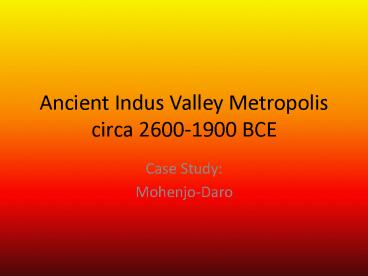Ancient Indus Valley Metropolis circa 2600-1900 BCE - PowerPoint PPT Presentation
1 / 24
Title:
Ancient Indus Valley Metropolis circa 2600-1900 BCE
Description:
Indus River Civilizationin modern day Pakistan. Importance of Location. Central Location b/w rivers: Ghaggar-Hakra & Indus. – PowerPoint PPT presentation
Number of Views:160
Avg rating:3.0/5.0
Title: Ancient Indus Valley Metropolis circa 2600-1900 BCE
1
Ancient Indus Valley Metropoliscirca 2600-1900
BCE
- Case Study
- Mohenjo-Daro
2
Indus River Civilizationin modern day Pakistan
3
Importance of Location
- Central Location b/w rivers Ghaggar-Hakra
Indus - Flood plain
- Rice fields for fall harvest
- Grazing land
- Vast scrub forest
- Wild Game Fishing
HEI Ghaggar-Hakra became a dry riverbed and the
Indus R. shifted
4
Citadel Mound
What does this picture reveal? Describe the types
of resources the Harappans used.
5
Great Bath (7m x 2.4m) State Granary/Great Hall
in background?
6
The Great Bath
7
Arch Drain from the Great Bath
8
Arch Drain Exit
9
Problems with Excavation! Buddhist Stupa on top
of citadel from the Kushana Period (circa 2nd
century CE)
10
First Street and Dead Mans Lane
11
Lower Street
12
Western Staircase of a House
13
House of a Noble/Leader?2 Doorways lead to lower
courtyard double staircase to upper courtyard
14
Well Surrounded by Paving(reconstructed)
15
Harappan Toilet?
Top Hole connected to a sm. Drain Most used old
pots set into the ground as commodes
16
Commerce Transportation
17
Copper WorkingShell Ivory CarvingsStone Tool
ProductionTerracotta PotteryStoneware
BanglesFired Steatite BeadsSeal Manufacturing
18
Necklace made from gold, agate, jasper, seatite,
green garnet
19
Glazed Tiles Indus Craftsmen used the practice
of glazing blue-green tiles
Tomb of Saint Shah Rukn-e-Alam in Multan
20
Investigate these artifacts!
21
Miniature Mask of a bearded horned deity
22
Cylinder Seals
23
Bull Seal
24
What does this seal depict?































